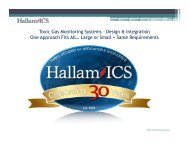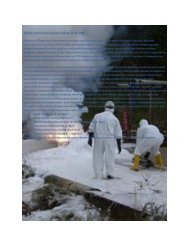SESHA 2011 Program Book - Semiconductor Safety Association
SESHA 2011 Program Book - Semiconductor Safety Association
SESHA 2011 Program Book - Semiconductor Safety Association
Create successful ePaper yourself
Turn your PDF publications into a flip-book with our unique Google optimized e-Paper software.
end-of-life disposal and recycling. This presentation will<br />
provide insight and lessons learned from First Solar’s life<br />
cycle management approach and it’s leading-edge efforts<br />
to implement a comprehensive environmental plan. Given<br />
the significant growth of the CdTe PV technology and its<br />
rapid deployment in the field it is critical that environmental<br />
impact data continue to be collected, analyzed, made<br />
public, and updated. In this presentation First Solar will<br />
provide an overview of its experiences and best practices<br />
in developing large-scale PV projects, including detailing<br />
the benefits and impacts of utility-scale PV projects<br />
on a life cycle basis. By the end of 2010, a total of more<br />
than 30GW of PV capacity will have been installed worldwide,<br />
and what happens to these products at the end of<br />
their useful life needs to be addressed. With a commitment<br />
to extended producer responsibility, First Solar, a leading<br />
manufacturer and developer of large scale projects, has<br />
implemented a comprehensive pre-funded module collection<br />
and recycling program. This presentation will provide<br />
details on how the overall program is designed to be convenient,<br />
unconditional, and free. First Solar will also share<br />
updated information on the recycling technology it has<br />
developed and implemented on a commercial scale ensuring<br />
that substantially all module components (by mass)<br />
are recovered for reuse in new solar modules or new glass<br />
products. By offering a collection and recycling program,<br />
the largest CdTe PV manufacturer is proving today that it<br />
is possible to manage waste concerns for the future while<br />
creating truly sustainable energy solutions today.<br />
2:30 pm GHG Reporting for the Electronics Industry<br />
- Determination of Reporting Applicability<br />
Cotter, D; Capaccio Environmental Engineering, Inc.<br />
Mr. Cotter will present a review of the U.S. EPA’s<br />
recently promulgated greenhouse gas (GHG) reporting<br />
rule for the electronics manufacturing industry (40 CFR<br />
Part 98, Subpart I). The presentation will include a review<br />
of the rule’s applicability criteria and how to use<br />
the equations in the regulation to determine applicability.<br />
The presentation will also discuss the rule’s requirements<br />
for monitoring, reporting, and record keeping,<br />
including the requirement to develop a written GHG<br />
monitoring plan by April 1, <strong>2011</strong>.<br />
3:15 pm Break & Raffle Drawing, Exhibit Hall<br />
17<br />
3:45-5:15 pm<br />
Disaster Preparedness Roundtable<br />
Sonora C<br />
3:45 pm Losses in the <strong>Semiconductor</strong> Industry –<br />
Case Studies and Lessons Learned<br />
Acorn , W; Acorn Consulting Services, LLC<br />
The author will discuss several large losses incurred<br />
by semiconductor and similar advanced manufacturing<br />
clients that resulted not only in business interruption,<br />
but significant out-of-pocket expenses. Case<br />
studies will address: 1. Fire in wafer fab – catastrophic<br />
losses, business interruption, lengthy litigation 2.<br />
Fire in flat panel display manufacturing facility - catastrophic<br />
losses, business interruption, lengthy litigation<br />
3. Chemical leak in wafer fab - catastrophic losses, business<br />
interruption, lengthy litigation 4. Alleged unsafe<br />
environments in wafer fabs result in employee claims<br />
and protracted lawsuits The author will address the impact<br />
of these cases not only from business interruption,<br />
but distraction of the owners’ employees from more productive<br />
endeavors.<br />
10:00 am-3:15 pm<br />
Abatement Strategies<br />
Sonora D<br />
10:00 am Point-of-Use Ammonium Compounds<br />
Removal - Keeping Exhaust Emission Clear<br />
Tsou, A, Chen, C-H, Hsiao, H-C; United Microelectronic<br />
Corp. (Singapore Branch), Singapore<br />
Hsuan-Chien Hsiao is with the United Microelectronic<br />
Corp. (Singapore Branch), No. 03, Pasir Ris Dr<br />
12, Singapore (Paul_Hsiao@umc.com) Chi-Hua Chen<br />
is with the United Microelectronic Corp. (Singapore<br />
Branch), No. 03, Pasir Ris Dr 12, Singapore Po-Wen Wu<br />
is with the United Microelectronic Corp., No. 3, Li-Hsin<br />
2nd Road, Hsinchu Science Park, Hsinchu, Taiwan 300,<br />
R.O.C. H-R Lai is with the United Microelectronic Corp.,<br />
No. 3, Li-Hsin 2nd Road, Hsinchu Science Park, Hsinchu,<br />
Taiwan 300, R.O.C. Abstract – Many wafer fabs face the<br />
challenge of managing effluent generated from compound<br />
semiconductor process-specific and that includes ensuring<br />
Point-of-use (POU) abatement devices meets the required<br />
or desired performance. For POU abatement systems, we<br />
usually focus on the main electric/fuel oxidation abatement<br />
mechanism but not on wet scrubbing section. It was<br />
found that poor abatement efficiencies of wet scrubbing<br />
could lead to environmental issues such as generation of<br />
fine particle at the stack and corrosion of exhaust duct.




